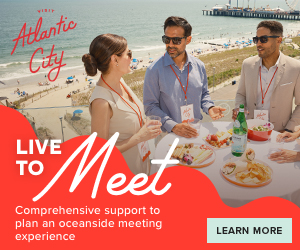
Music As A Collaborative Tool

Contributed by: Angus Clark
Music, in its many forms, satisfies different needs for different people. For some meeting planners, it is a tool that we wield with precision and flair, and for some of us it is a mysterious artifact that we are completely at a loss for how to control (think “arc of the covenant”). This article will shed some light on how to use music as a collaborative tool without having to unravel the mysteries of the ages.
It is reasonable to say that music has universal appeal. Also, research by neuroscientists has demonstrated that people get a sensory reward by listening to familiar music. This reward is delivered in the form of dopamine – sometimes referred to as “the pleasure chemical.”
At a conference or seminar, planners can use music to tap into that sense of familiarity and by doing so trigger those positive feelings. We can also get people to collaborate on projects involving music so that there is a lasting connection between that sense of positivity and the collaborative process. The end result being the notion that “working together with people makes me feel good!” And that is a win.

SHARED MUSICAL EXPERIENCE
Everyone has experiences that involve music. We can draw that out by asking a simple question, such as “What was the first concert you ever attended?” This immediately inspires connections between conference attendees as they start sharing memories of going to a Garth Brooks, Beyoncé, Rolling Stones, or Public Enemy concert.
As a musician, when I am leading a program, I can riff off these memories by playing a few notes of “Satisfaction” or “Friends in Low Places” to ignite a sonic thread that immediately draws people closer. They smile, nod their heads collectively, and share knowing glances and laugh. The same result can be obtained with a strong command of search terms and a Spotify connection. Make the music in the room respond to the people.
Establishing these connections between attendees is the first step in demonstrating the power of music. Once that is established, we can further demonstrate applicable lessons from the world of songwriting and performing that can be incorporated into a great team-building experience.

COLLABORATION THROUGH SONG
The programs that I facilitate rely on my experience as a rock guitarist and performer in addition to my real-world experience working in an office. These two worlds aren’t as different as you might think. Communication, collaboration and creative problem-solving are at the heart of an innovative workplace or a hit songwriting session.
I am a strong proponent of musical education and calling upon experts in any given field when they are needed. For the purposes of a collaborative exercise, people are empowered to have an opinion about music without knowing anything technical about it. What is important is how they are experiencing it: Do they prefer it louder, softer, faster, or slower? Do they like reggae, hip hop, rock, or country?
All collaborative exercises need a common goal and a process to follow. Our common goal is writing a song. We have a framework for collaboration that everyone can follow with or without previous musical experience.
This is how it works…We encourage tables of attendees at a conference to share with each other themes and ideas unique to their profession or business. After a little instruction in rhyming and song writing, we turn them loose to collaborate at their tables to write those experiences and ideas as song lyrics. Some are funny and some are serious, but all of those experiences resonate with all the attendees in the room.
By the end of the session, we are able to combine various lyrics and apply them to a simple melody. We poll the room to establish consensus regarding style, feel, tempo, etc. Attendees stand up, clap, sing, and dance while the song is performed. Soon the whole room is engaged in performing THEIR song.
Click below to take a look at how music is used as a collaborative tool at events…
ADD MUSIC TO YOUR TOOL KIT
This process is just one example of how music can be tamed into a usable tool for your meetings or events. If music is not the focus of your collaborative exercise, it can be a wonderful accompaniment.
By incorporating music into events, not only have we demonstrated the power of collaboration, but we’ve also used song to strengthen our bond as a team through the power of music and have had a whole lot of fun doing it. People leave the conference humming this new creation, buoyed with the positive energy that music releases within us.

Written by:
Angus Clark
General Manager and Music Director
SongDivision
Angus Clark is the general manager and music director of SongDivision Americas. He is the lead guitarist for the Trans-Siberian Orchestra and performed in the onstage band for the Broadway musical “Rock of Ages.” SongDivision builds corporate culture through music. Their team of world-class musicians work to understand business goals and use music to communicate cultural values and brand messages at meetings and events.
For more information, contact Angus Clark at Angus@songdivision.com


1 comment
Leave a commentOrder by
Newest on top Oldest on topMusic as a collaborative art form thrives on the synergy between artists, each bringing their unique
Music as a collaborative art form thrives on the synergy between artists, each bringing their unique talents and perspectives to create something greater than the sum of its parts. From songwriting to production, musicians often collaborate to blend diverse styles and ideas, resulting in innovative and dynamic compositions. This collaborative spirit extends beyond musicians to include producers, engineers, and even visual artists, all working together to craft memorable musical experiences. Celebrities often contribute to this dynamic by leveraging their influence to bring attention to new artists or genres, amplifying the impact of collaborative efforts and enriching the cultural tapestry of music.Read full comment